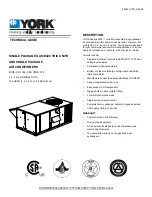
3
Safe Refrigerant Handling
While these items will not cover every conceivable situa-
tion, they should serve as a useful guide.
To avoid possible injury, explosion or death, practice
safe handling of refrigerants.
WARNING
To avoid possible explosion:
Never apply flame or steam to a refrigerant cylinder.
If you must heat a cylinder for faster charging,
partially immerse it in warm water.
Never fill a cylinder more than 80% full of liquid re-
frigerant.
• Never add anything other than R-22 to an R-22 cy-
linder. The service equipment used must be listed
or certified for the type of refrigerant used.
• Store cylinders in a cool, dry place. Never use a cy-
linder as a platform or a roller.
•
•
To avoid possible explosion, use only returnable (not
disposable) service cylinders when removing refrig-
erant from a system.
• Ensure the cylinder is free of damage which could
lead to a leak or explosion.
• Ensure the hydrostatic test date does not exceed
5 years.
• Ensure the pressure rating meets or exceeds 400
lbs.
When in doubt, do not use cylinder.
WARNING
Refrigerant Lines
The compressor mineral oil for R-22 units is susceptible to
moisture absorption and could cause compressor failure.
Do not leave system open to atmosphere any longer than
necessary for installation.
CAUTION
NOTE:
For improved refrigerant management, equip the
evaporator coil with a field-supplied thermal expansion valve
(TXV) and the liquid line with a field-supplied liquid line
solenoid. Ensure the solenoid is installed as close as possible
to the evaporator coil to prevent refrigeration migration in the
compressor “OFF” cycle.
Use only refrigerant grade (dehydrated and sealed) copper
tubing to connect the condensing unit with the indoor evapo-
rator. After cutting the tubing, install plugs to keep refriger-
ant tubing clean and dry prior to and during installation. Tub-
ing should always be cut square keeping ends round and
free from burrs. Clean the tubing to prevent contamination.
Do NOT let refrigerant lines come in direct contact with plumb-
ing, ductwork, floor joists, wall studs, floors, and walls. When
running refrigerant lines through a foundation or wall, open-
ings should allow for sound and vibration absorbing material
to be placed or installed between tubing and foundation. Any
gap between foundation or wall and refrigerant lines should
be filled with a pliable silicon-based caulk, RTV or a vibration
damping material. Avoid suspending refrigerant tubing from
joists and studs with rigid wire or straps that would come in
contact with the tubing. Use an insulated or suspension type
hanger. Keep both lines separate and always insulate the
suction line.
These sizes are suitable for line lengths of 74 feet or less. If
a run of more than fifty feet is required, refer to Remote Cool-
ing Service Manual, or TP-106 Long Line Set Application R-
22, or contact your distributor for assistance.
Suct
Liq
Suct
Liq
Suct
Liq
7 1/2
1 1/8
5/8
1 3/8
5/8
1 3/8
5/8
10
1 3/8
5/8
1 5/8
5/8
1 5/8
5/8
Cond Unit
(Tons)
REFRIGERANT LINE LENGTH (ft)
0-24
25-49*
50-74**
Line Diam eter (In. OD)
* Full rating line size
** Lines greater than 74 f eet in length or vertical elevation
changes more than 50 f eet
r e fe r to the Re m ote Cooling
Se r vice M anual or contact your dis tr ibutor for as s is tance .










































